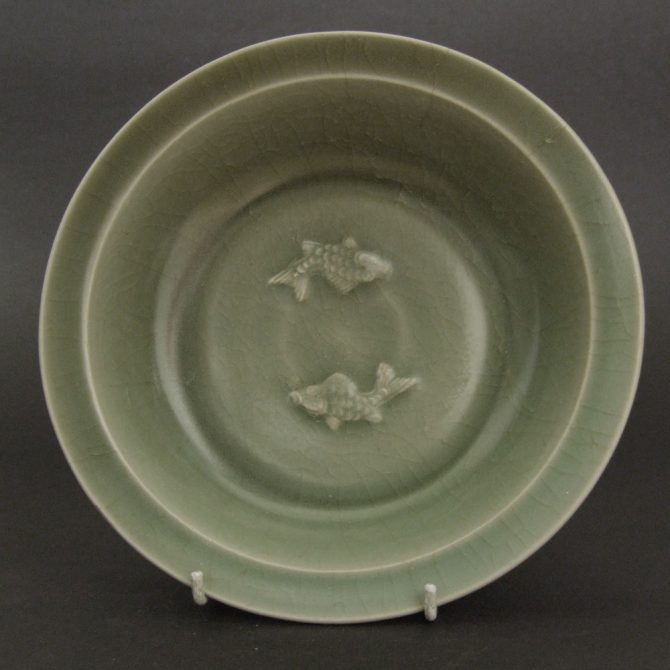
SOUTHERN SONG 1127 – 1279 or YUAN DYNASTY 1279 – 1368. Celadon Ware.
A Longquan Celadon ‘Twin Fish’ Dish, Southern Song or Yuan, 13th or Early 14th Century. From the Longquan Kilns, Zhejiang Province. The Celadon Glaze of this Dish is a Good Dark Slightly Smoky Green, it is Quite Translucent with the White Body Showing Through Clearly. The ‘Twin Fish’ Appliqué, a Symbol of Harmonious Marriage, are Well Moulded with Detail that Shows Through the Glaze.
SOLD
- Condition
- Poor, three large uneven rim cracks, these are difficult to see or measure as the glaze is crazed, measure approximately 35 mm each. The start of one of the cracks has a small 'V'-shape section of the rim re-stuck c.8 x 8 x 6 mm.
- Size
- Diameter : 22 cm (8 1/2 inches)
- Provenance
- N/A
- Stock number
- 20276
- References
- For a similar but slightly larger celadon dish see : Chinese Celadons And Other Related Wares In Southeast Asia (Southeast Asian Ceramic Society, Singapore. Arts Orientalis, Singapore.1979) page 176 plate 93.
Information
Celadon is a term used to describe several types of Chinese stoneware and porcelain, as well a ceramics from other countries, notably from Korea and Japan. The term is a imprecise one, applying to various types of green glazed ceramics, but not all ceramics with green glazes, there are several wares that have a green glaze that are not refereed to as celadon. For example Green Jun and Ge Ware. For this reason there has been a move to try to clarify the situation by using the term 'Green Ware'. But for now Celadon is a more familiar and therefore useful term. The origins of the term Celadon are not clear, one theory is that the term first appeared in France in the 17th century and that it is named after the shepherd Celadon in Honoré d'Urfé's French pastoral romance, L'Astrée (1627), who wore pale green ribbons. (D'Urfe, in turn, borrowed his character from Ovid's Metamorphoses.) Another theory is that the term is a corruption of the name of Saladin, the Ayyubid Sultan, who in 1171 sent forty pieces of the ceramic to Nur ad-Din, Sultan of Syria. Yet a third theory is that the word derives from the Sanskrit sila and dhara, which mean "stone" and "green" respectively.
Celadon ware originated in Zhejiang Province in the Eastern Han Dynasty, however green monochrome glazes can be found on stoneware much before that date. Zhejiang is were the famous Longquan Celadons were made but Celadon wares were also produced at Jiangsu, Hubei, Hunan and Jiangxi. The production of Celadon Ware required a reducing atmosphere of around 1300 degrees C., the colouring agent was a mixture of iron oxide and titanium. The glaze was applied very thickly, and was full of tiny bubbles which defuse the light giving the appearance of richness and softness.

